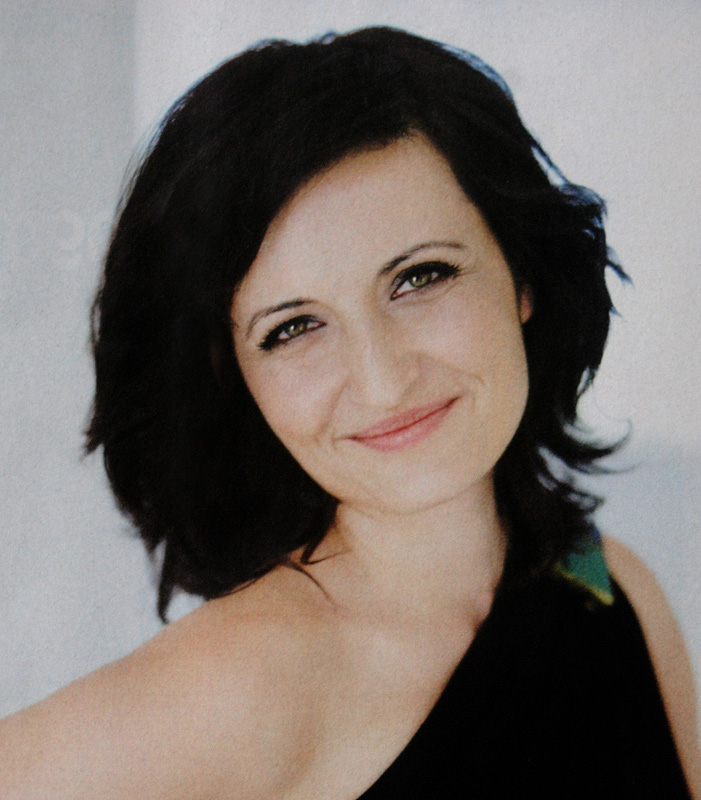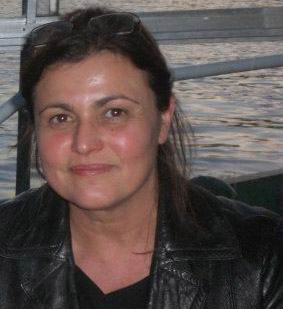Gabriella Csoszó in Conversation with Hedvig Turai (Interview)
 Gabriella Csoszó (1969) is a Hungarian artist currently living and working in Budapest. Csoszó displays a unique series of photographs, specifically portraits, which examine identity and individuality. Csoszó uses texts, fragments, and often installations to accompany her pictures. She is presently exhibited at Paris Photo by Raday Gallery. Most recently, Csoszó has been experimenting with landscapes, deteriorated buildings, and construction sites that reveal traces of the recent past, on the Cold war period. Currently she is working on the photographic recording of the Georg Lukács Archive in Budapest, focusing on its history with curator Lívia Páldi.
Gabriella Csoszó (1969) is a Hungarian artist currently living and working in Budapest. Csoszó displays a unique series of photographs, specifically portraits, which examine identity and individuality. Csoszó uses texts, fragments, and often installations to accompany her pictures. She is presently exhibited at Paris Photo by Raday Gallery. Most recently, Csoszó has been experimenting with landscapes, deteriorated buildings, and construction sites that reveal traces of the recent past, on the Cold war period. Currently she is working on the photographic recording of the Georg Lukács Archive in Budapest, focusing on its history with curator Lívia Páldi.
http://www.fotokontakt.hu/csoszo.html
Hedvig Turai: How do you view your position in the world of photography and contemporary art in Hungary?
Gabriella Csoszó: As a student I studied fine art, and I have been exhibiting my photographs, series of photos, and photo installations since the beginning of my career. Due to this, most of my works can be interpreted within the medium of photography. However, I often use other media as well. I use text frequently, and a video piece has recently become an integral part of one of my latest works. I think it is detrimental to approach my works via the medium because I am not primarily dealing with questions and problems surrounding photography itself. I am interested in issues, and naturally I use different genres such as video, documentation, or film as the project demands. These media are evident, and they lead to the problems I immerse myself in.
In general the Hungarian language and the artistic scene make it difficult to call a photographer an artist without some kind of irony or connotations attached. Using varied media in art, despite its increasing relevance, does not make it easier to define the status of the artist or the medium. In English these terms are readily available, but in Hungarian there is no consensus as to the exact meaning of certain terms. Furthermore, the use of these terms is often convoluted. There are no appropriate and precise Hungarian terms to describe certain rising artistic phenomena or new types of artistic performances. In addition, certain terms carry unwanted, conservative connotations. For example terms such as “photo-artists” or “photographer,” which may sound strange in other languages, evoke an archaic connotation in Hungarian. The vagueness of the terminology is the cause of this confusion.
However, I do understand the underlying principle at the basis of the terminological ambiguity. Hungarian art has long been characterized by a division between photography and art. In contemporary exhibitions, the integration of the two is customary, but on an institutional level the situation is quite different. The institutions and administrations still use the traditional distinction between art and photography to define status, and more importantly, to allocate funds.
H.T.: Compared to your earlier works, it seems to me that you are now more interested in objects and scenery. It is as though people have disappeared from your images. Please explain why and how your focus has changed?
G.Cs.: My earliest works had a more personal tone, and were self-reflexive in different ways. In these early pieces I focused on my personal life and I included the spaces in my lifeas well as my step-siblings. This personal theme appeared in my photo series Without Regards With My Family was a similar series of photographs in which I displayed images of my family members with their eyes closed. Later on my focus shifted to the depiction of a relationship’s narrative, and this move can be seen in Map, Missing Images, and Part. In these later works the motifs of space, background scenery, the act of walking, and the process of searching commonly appear. Soon after, I turned to the idea of community, but as understood community in a broader sense, as seen in Cherry Trees. From there I began to focus on raising social questions in my works, which can be seen in Free Copies, and in Retransmission Timeout. These two pieces are related and interconnected, leading into one another in both content and form. One of the works guides the viewer to another, sometimes through its content and sometimes through an aspect of the image.
Despite the specific progression outlined above, one of my latest photo series, entitled Tie a Tie, highlights the relationship dynamics at play between my mother and my father. In this collection of images one views photographs of the middle-aged couple working together to tie a tie. It is a film-like series, a sequence where one follows the action and then chooses whether or not to interpret that action as symbolic. It is a special kind of Eastern-European “silent film” displaying the cooperation necessary for a couple to live together for more than forty years. In this piece, one can get a sense of the interactions between couples that are beyond words and the heavy burden that is placed on a woman in a relationship. Specifically the series shows that without women, even in the most banal situation, a family will struggle to function properly. In our family, my father was typically the authority. However, in this situation, he is confounded while my mother controls the scene. The setting is a room in our country house, and on the walls there are framed photos of my nephews, all wearing the same type of “tied ties”. Although one can read the set of images in many different ways, my personal view is that the images portray understanding, empathy, and the rejection of a traditional female role.
H.T.: Many of your photos are accompanied by texts or actions, such as walking. What is the relationship between image and text, image and action? Who is the author of these texts?
G.Cs.: I have some works where the photos are simple documentations. The personal, sometimes lyric, tone comes from the use of personal letters and texts. The personal element provides these works with a sensitive and intimate tone, and the question as to whether or not the person is real or fictitious should remain an enigma. Here, I am again concerned with the relations between works as opposed to media-related questions. It is the creative process as a whole that is important to me. Every detail becomes part of the work, part of the exhibition. Planning, putting it into a context, and meeting the audience, these are all elements that together make a piece of art.
H.T.: How do you choose your objects? Do they come to you accidentally? What do they represent?
G.Cs.: The thematic focus and basic gestures, all the preparation for a piece, is something I try to stay conscious of, and plan well. However, sometimes there is an element of unpredictability that occurs when finding and taking photographs. In other words, I try to be open to spontaneous diversions from my original plan. In fact, I found the subject for my first piece concerning Hungary’s recent history by accident. I had unexpectedly found discarded books in the Open Society Archive, from the collection of books of the Library of Radio Free Europe, in Budapest. I felt that if I did not record thisfind then it would soon disappear and since I happened to be there, and I felt it was my obligation to document and photograph it. The selection and discarding of books in Hungary was an important part of a certain historical period. These pictures have changed me because they made me confront certain issues. My subsequent series dealing with the Cold War, abandoned historical spaces, objects of recent history and archives waiting to be reconsidered grew from this process.
When taking a photo, I start with a need for documentation. The scenes, the objects, and the situations can be viewed as untouched and unaffected reality. However, installations and exhibitions are different. Both bring a new system of relations and meanings to a piece. In an installation or exhibition, the observer meets a carefully composed series of pictures that gain new meanings from the evolving context. The meaning is manifold and the images can be received in many different ways, additionally leaving room for the thoughts of the spectator. My works should be interpreted, not individually, but within a system of relations between art and spectator.
As previously mentioned, my interest lies in the scenes and situations of recent history that are awaiting a reevaluation. A lot of questions have been brought up about the history of East Central Europe since the political changes have taken place, but the process of reevaluating and reconsidering this history has not yet been completed; in some cases, it has not even begun.
The remnants of the past, relics that were once of high importance, are now symbols of ambiguity. Their peripheral, abandoned, and vanishing state raises legitimate questions about the system of power and its preservation. An especially important issue affecting our region is that of the problem of archiving. The writing and finding of historical facts changes from period to period, and I feel the responsibility to raise and formulate questions about these changes. It is important that this is a process parallel to the growing interest in the archive, and thinking about the archive’s role in the world. The present political situation in Hungary coupled with the incidents occurring during the last few months makes this issue even more important. It is clear how the government utilizes and abuses the fact that these issues have been ignored.




